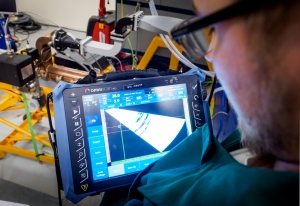Material research in NCBJ for the Polish nuclear power programme
23-11-2017
On an assignment from the Polish Ministry of Energy, NCBJ Material Research Lab has worked out guidelines for Polish companies involved in construction of nuclear power plants (NPPs). Guidelines how to conduct non-destructive and destructive tests of elements to be deployed in such plants have been compiled into a 50-page report.
The report (in Polish: “Wytyczne wspomagające działania przedsiębiorstw krajowych w budowie elektrowni jądrowych”) gives description of the methods used to assess quality and nuclear safety of individual elements to be deployed in NPPs (both at their production stage and during the plant operation). It is also a guide to domestic and foreign technical standards applicable in this area. The report will be made available to every company interested in participation in the Polish nuclear power programme.
Developers of NPPs constructed anywhere in the world must meet very stringent quality and safety standards. Plant safety depends directly on quality of elements/systems/materials supplied by vendors/subcontractors. Increased safety requirements apply to suppliers of all plant elements, starting from fuel elements, pipelines/tubes/tanks and structural elements, to concretes and sealing masses. If the project to develop the first NPP in Poland kicks off, any Polish company interested to participate will have to meet similar requirements. To meet the highest quality standards, very often materials/parts/subassemblies must be produced from the very beginning with safety in mind.
Among numerous methods to control quality of materials/products/constructions, non-destructive tests play a particular role: they may be applied at the factory, on the construction site, and later during operation of the plant. The report presents six non-destructive test methods most commonly used in practice to evaluate quality of typical elements manufactured for nuclear facilities. They include: visual inspection; penetration; magnetic-powder; eddy currents; radiography; ultrasonography. The choice depends on specifics of the to-be-tested material/product/construction. Visual inspection is the simplest method but a vast knowledge and experience of the inspector is needed. In the penetration and magnetic-powder methods, possible structural defects within the tested material are revealed in result of their chemical or magnetic interaction with some substances deposited on the material surface. Each method may be applied only by properly certified inspectors. It is a multi-year and multi-stage process to acquire the required competences. The applicable standards and “good-practice” procedures are also described in the report. Currently NCBJ is the sole centre in Poland, in which a nuclear reactor is operated. Quality of reactor systems and subassemblies is tested systematically. Therefore professional qualifications and competences of NCBJ experts have become established during many years of practice.
NCBJ Material Research Lab is a certified body. It conducts research for NCBJ’s own needs, as well as accepts external assignments. These activities help to maintain a high level of competences of its staff in evaluation of functional properties of materials and quality assurance.
Within framework of the assignment from the Polish Ministry of Energy, NCBJ Material Research Lab will organize a seminar targeted especially on potential industrial partners of the Polish NPP programme. Topics to be discussed include: (i) training and certification of personnel; (ii) legally binding methods of destructive/non-destructive quality testing; (iii) nuclear reactor underlying principles. The seminar will be held at premises of the Świerk Science & Technology Park on November 30, 2017. All interested persons are invited.





